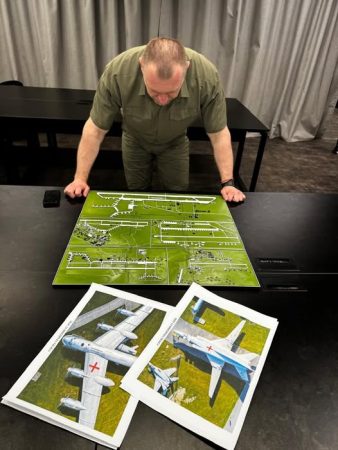Ukraine’s successful attacks on bombers deep within Russia using relatively inexpensive drones will certainly affect the progress of that war, but don’t offer a practical new model for the structure of U.S. airpower, two experts said.
While innovative, the raids did not herald a new era of air warfare, which still demands aircraft that can reach far across the globe to hold targets at risk, they said.
In a daring raid launched June 1, Ukraine sent semitrailers loaded with 117 attack drones to locations near Russian bomber bases. As seen in on-scene video footage, the drones launched from false tops in the trucks and flew to the nearby flightlines, where they individually attacked parked aircraft.
While Ukraine initially claimed to have destroyed “more than 40” aircraft in the raid, it later revised that to “at least 13.” Nevertheless, cameras on some of the drones, as well as commercial satellite imagery, showed heavy damage to many aircraft—including Tu-195 “Bear” and Tu-22 “Backfire” bombers—which are out of production and cannot be replaced. Those aircraft were targeted, the Ukrainian SBU security service said, because they have launched many cruise missiles into Ukraine, frequently from well inside Russian airspace. Also hit were an A-50 “Mainstay” airborne warning and control aircraft and cargo planes.

The attacks were carried out simultaneously across the breadth of Russia, not only in locations close to Ukraine but as far as Belaya air base, more than 2,600 miles from Ukraine in the Irkutsk region of Russia.
Those aircraft not destroyed outright may still have to be written off, because the drones attacked their wingboxes—the crucial load-bearing area of an aircraft that carries its weight, and through which most wiring bundles and control mechanisms pass.
Air Force Chief of Staff Gen. David W. Allvin, speaking at the AI+ Expo in Washington on June 2, addressing the unconventional operation, noted that innovation in combat “is growing so much more rapid. . . . It should humble us.”
The Ukrainian strike demonstrates that the idea of sanctuary from attack is “sort of going away as a concept,” as is the idea that forces must fight across great distances to reach their targets, he said.
“Why don’t we think about including that in our Air Force, and doing like the Ukrainians do?” Allvin asked.
Airpower experts from the Air and Space Forces Association’s Mitchell Institute for Aerospace Studies, however, said the operation, while certain to affect the Ukraine war, isn’t necessarily a template for the Air Force to follow.
“I would caution against interpreting this innovative strike as something more than it was,” said Mark Gunzinger, Mitchell’s director of future concepts and capability assessments.
“Was it potentially game-changing in the sense of a European conflict? Absolutely, but the drones used for the attack were transported into Russia via ground vehicles, which would not be a viable means to conduct very long-range strikes in a western Pacific fight,” Gunzinger said.
But he went further than Allvin, saying the era of operating out of safe spaces is over, both at home and abroad.
“Too many people still believe the U.S. will be a sanctuary from kinetic attacks during a future war,” Gunzinger said. “On the contrary, we must expect our homeland bases and forces will be attacked by long-range missiles, uninhabited aircraft, and by unconventional means, like Russia just experienced.”
Gunzinger argues that the drones acted more as mobile artillery or cruise missiles, not combat aircraft with the range, stealth and weapons to succeed in dangerous airspace. The drone attacks showed that “one of the best ways to take out an enemy’s air force is when it’s . . . on the ground,” he added.
The U.S. must be able to do the same, Gunzinger said. But rather than spend money on an army of small drones that can strike at close range, he said, the Air Force should invest in “capacity to strike deep into contested areas.”
The Air Force needs the new B-21 Raider bomber and next-generation F-47 fighter, he said, because “no other service” or allied nation can provide those capabilities.
The Russia strike provides abundant evidence, though, that “we must invest in defenses against these threats abroad and in our homeland, and do so now, before we experience a similar strategic shock,” Gunzinger said.
He echoed remarks from former Air Force Secretary Frank Kendall that the Air Force “can no longer wait for the Army” to fund and develop missile defenses for air bases, a mission assigned to the Army in 1947.
“Our Air Force must prepare to defend its own bases and forces,” Gunzinger said. The Army has “neglected” the air base defense mission for decades, he argued, “in favor of acquiring highly redundant capabilities like long-range strike missiles and fixed-wing [intelligence, surveillance and reconnaissance] aircraft.”
Congress “must provide the Air Force with additional funding and end strength for air base defense, since robbing its other modernization programs to resource a new mission would risk prolonging its status as the oldest and smallest U.S. Air Force ever,” he added.
Asked what the Air Force is doing to defend against similar drone incursions—now that mass attacks against parked aircraft are no longer hypothetical—a service spokesperson said that the commanders of U.S. Northern Command and Indo-Pacific Command “are the lead synchronizers for operations to counter” unmanned aerial systems.
“Our forces maintain a high state of readiness to defend against a wide range of threats,” including “emerging UAS and drone swarms,” a defense official said through a spokesperson.
“We [the DoD] are developing a range of capabilities that can evolve to counter this threat across all components of the kill chain that include detection, tracking, identification/classification, and defeat, both with kinetic and non-kinetic capabilities,” the official said. “We continuously invest in layered air and missile defense technologies, early warning systems, and rapid response protocols designed to detect, track, and neutralize airborne threats well before they can reach critical assets.”
Retired Lt. Gen. David Deptula, head of the Mitchell Institute, called the drone strikes “a compelling example of applying an effects-based approach to operations to achieve classic counter-air objectives.”
Lacking bombers, stealth aircraft, an “ISR-strike kill chain” or the ability to suppress enemy air defenses, Ukraine “had to come up with an innovative means to effectively project power to accomplish their desired effects,” Deptula said. So the country seized on the solution of “cheap, easy-to-produce and tactically effective” precision-guided munitions—largely quadcopters laden with explosives—that could get most of the way to their targets on trucks.
Taking this approach, Ukraine achieved a “strategic effect: neutralizing enemy airpower at its source,” he said, and it’s time the U.S. military renewed its focus on “an effects-based approach to operations.”
Although the raids are focusing attention on the vulnerabilities of aircraft parked in the open, “infantry, tanks, ships . . . logistics storage” and other attractive targets are also susceptible to such attacks, Deptula said.
The danger posed by “cheap, small, and numerous precision-guided munitions are significant, and must be addressed by the entire U.S. military with equally innovative defensive measures,” he said.
All U.S. military branches “must act swiftly to prioritize base and area defenses, decentralize operations, and in the case of the Air Force, advocate for funding to ensure its aging fleet is not only recapitalized but also protected,” he said, calling any element of military power that can’t survive enemy threats a “hollow deterrent.”
Defense Secretary Pete Hegseth should cut the Army’s effort to build hypersonic missiles that are “too destabilizing in peacetime to be deployed by our allies, and use up too much lift to be practical in wartime,” Deptula said. Instead, the Pentagon should use those resources to build effective counter-drone capabilities and base defenses.
“Leadership and candor will be required to make this happen,” he added.
He argued for renewed emphasis on hardened aircraft shelters and force protection.
“Since the end of the Cold War, none of the U.S. armed forces have made force protection a priority due to several factors, not the least of which is cost, and the perceived absence of threat. That is no longer the case,” he said.
Efforts to place hardened shelters on Guam, a strategic U.S. outpost that would be a key military hub in a conflict with China, for B-2 Spirit bombers and F-22 Raptors didn’t bear fruit because DOD leaders view “the risk of a conflict affecting aircraft on Guam and in the continental U.S. as an acceptable risk to take,” Deptula said.
He hopes Russia losing so much of its long-range aviation at once “will get the attention of the DOD leadership.”


